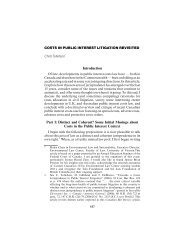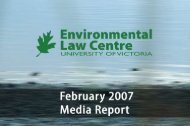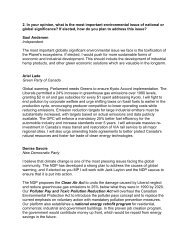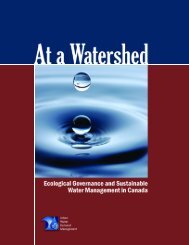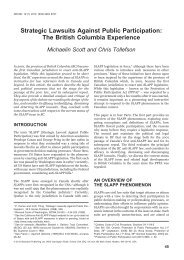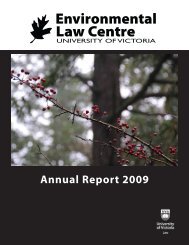Peeling back the Pavement - POLIS Water Sustainability Project
Peeling back the Pavement - POLIS Water Sustainability Project
Peeling back the Pavement - POLIS Water Sustainability Project
Create successful ePaper yourself
Turn your PDF publications into a flip-book with our unique Google optimized e-Paper software.
Endnotes<br />
1. McFarlane, S. & Nilsen, E. (2003). On Tap: Urban <strong>Water</strong> Issues in Canada Discussion Paper. Canada<br />
West Foundation. Retrieved from www.gordonfn.org/resfiles/CWFwaterreport.pdf<br />
2. McGuire, G., Wyper, N., Chan, M., Campbell, A., Bernstein, S., & Vivian, J. (2010, February). Re-inventing<br />
Rainwater Management: A Strategy to Protect Health and Restore Nature in <strong>the</strong> Capital Region.<br />
Victoria, Canada: The Environmental Law Centre at <strong>the</strong> University of Victoria. Retrieved from www.elc.<br />
uvic.ca/press/documents/stormwater-report-FINAL.pdf<br />
3. Canadian Council of Professional Engineers. (2008, April). Adapting to Climate Change: Canada’s<br />
First National Engineering Assessment of Public Infrastructure. Ottawa, Canada: Engineers Canada.<br />
Retrieved from www.pievc.ca/e/Adapting_to_climate_Change_Report_Final.pdf; Kitchen, H.M. & Slack,<br />
E. (2006, May 24). Trends in Public Finance in Canada. Toronto, Canada: University of Toronto. Retrieved<br />
from www.utoronto.ca/mcis/imfg/pdf/trends%20in%20public%20finance%20in%20Canada%20-%20<br />
June%201.pdf<br />
4. Bowles, G. (2002, Summer). Impervious Surface: An Environmental Indicator. The Land Use Tracker,<br />
2(1). Retrieved from www4.uwsp.edu/CNR/landcenter/tracker/summer2002/envirindic.html; Recent<br />
estimates suggest that <strong>the</strong>re are 25 million acres of impervious surfaces in <strong>the</strong> United States—nearly<br />
one-quarter of non-federal land. See Kloss, C. & Calarusse, C. (2006, June). Rooftops to Rivers: Green<br />
Strategies for Controlling Stormwater and Combined Sewer Overflows. Natural Resources Defense Council.<br />
Retrieved from www.nrdc.org/water/pollution/rooftops/rooftops.pdf<br />
5. Bélanger, P. (2008). Urban Stormwater Economics: A Comparative Cost-Benefit Study of Site Technologies<br />
& Strategies for <strong>the</strong> City of Toronto. In Kesik, T. & Miller, A. (2008). Toronto Green Development<br />
Standard Cost Benefit Study. Toronto, Canada: The Faculty of Architecture, Landscape, and Design at <strong>the</strong><br />
University of Toronto. Retrieved from www.toronto.ca/planning/environment/pdf/appendix_d.pdf<br />
6. Greater Vancouver Regional District. (2000). Liquid Waste Management Plan–Stage 2: Policies and<br />
Commitments. Retrieved from www.dnv.org/upload/documents/council_reports/186445A.pdf<br />
7. Bitti, M. T. (2010, March 9). Facing Canada’s water woes. Financial Post. Retrieved from www.financialpost.com/executive/smart-shift/water/Facing+Canada+water+woes/2660041/story.html<br />
8. Mirza, S. (2007, November). Danger Ahead: The Coming Collapse of Canada’s Municipal Infrastructure.<br />
Ottawa, Canada: Federation of Canadian Municipalities. Retrieved from http://www.fcm.ca//<br />
CMFiles/mdeficit1OPT-792008-3425.pdf; Some experts have suggested this number is underestimated<br />
by hundreds of billions of dollars. (P. Lucey, personal communication, June 8, 2011).<br />
9. For a discussion of sufficiently high water rates see Brandes, O. M., Renzetti, S. & Stinchcombe, K.<br />
(2010 May). Worth Every Penny: A Primer on Conservation-Oriented <strong>Water</strong> Pricing. Victoria, Canada: The<br />
<strong>POLIS</strong> <strong>Project</strong> on Ecological Governance at <strong>the</strong> University of Victoria. Retrieved from www.poliswaterproject.org/publication/344<br />
10. Bélanger, P. (2008).<br />
11. Cited in Mercer, K. (2011, April 1). Damage Control. <strong>Water</strong> Canada. Retrieved from watercanada.<br />
net/2011/damage-control/. See also: Infrastructure Deficit Makes Way for <strong>the</strong> Deluge: Climate Change<br />
Elevates Storm <strong>Water</strong> Management Concerns. (2008, November). Canadian Property Management.<br />
Retrieved from www.canadianpropertymanagement.ca/InfrastructureDeficitMakesWayfor<strong>the</strong>.aspx.<br />
For international discussion see: Consumer Focus. (2009, October). Adaptation to a Changing Climate:<br />
Today’s Investments in Tomorrow’s Climate. Retrieved from www.consumerfocus.org.uk/files/2011/05/<br />
Adaptation-to-a-changing-climate.pdf<br />
12. Statistics Canada. (2009, December 7). Local government revenue and expenditures. Retrieved<br />
from http://www40.statcan.ca/l01/cst01/govt52a-eng.htm These costs are compounded by <strong>the</strong> fact<br />
that <strong>the</strong> gross stock of water supply infrastructure increases by an average 5.1 per cent each year, ten<br />
times faster than <strong>the</strong> rate for roads and bridges; Statistics Canada. (2009, November 12). Age of Public<br />
Infrastructure: A Provincial Perspective. Retrieved from http://www.statcan.gc.ca/pub/11-621-m/11-<br />
621-m2008067-eng.htm Between 1972 and 1996, Canadian water withdrawals increased by almost<br />
90 per cent, yet population grew by just over 30 per cent; Environment Canada. (2009, November<br />
26). <strong>Water</strong> Conservation – Every Drop Counts. Retrieved from www.ec.gc.ca/eau-water/default.<br />
asp?lang=En&n=3377BC74-1<br />
61



